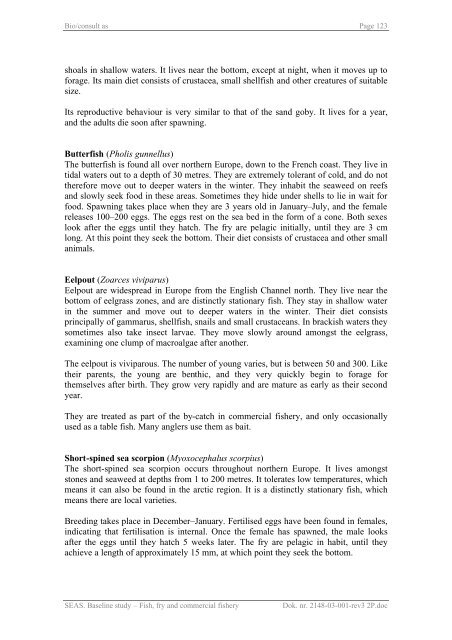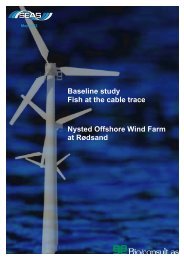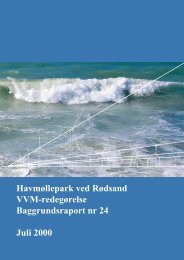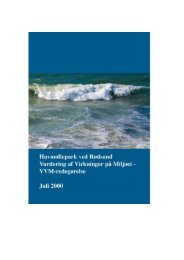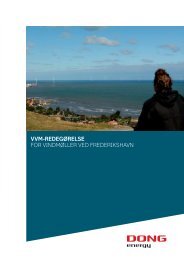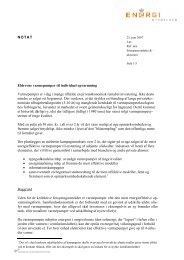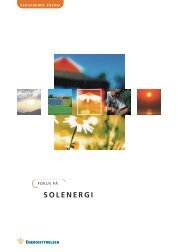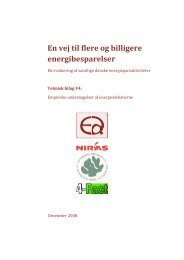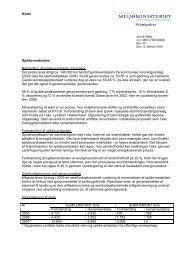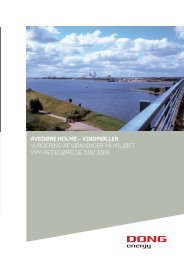Baseline study Fish, fry and commercial fishery Nysted Offshore ...
Baseline study Fish, fry and commercial fishery Nysted Offshore ...
Baseline study Fish, fry and commercial fishery Nysted Offshore ...
You also want an ePaper? Increase the reach of your titles
YUMPU automatically turns print PDFs into web optimized ePapers that Google loves.
Bio/consult as Page 123<br />
shoals in shallow waters. It lives near the bottom, except at night, when it moves up to<br />
forage. Its main diet consists of crustacea, small shellfish <strong>and</strong> other creatures of suitable<br />
size.<br />
Its reproductive behaviour is very similar to that of the s<strong>and</strong> goby. It lives for a year,<br />
<strong>and</strong> the adults die soon after spawning.<br />
Butterfish (Pholis gunnellus)<br />
The butterfish is found all over northern Europe, down to the French coast. They live in<br />
tidal waters out to a depth of 30 metres. They are extremely tolerant of cold, <strong>and</strong> do not<br />
therefore move out to deeper waters in the winter. They inhabit the seaweed on reefs<br />
<strong>and</strong> slowly seek food in these areas. Sometimes they hide under shells to lie in wait for<br />
food. Spawning takes place when they are 3 years old in January–July, <strong>and</strong> the female<br />
releases 100–200 eggs. The eggs rest on the sea bed in the form of a cone. Both sexes<br />
look after the eggs until they hatch. The <strong>fry</strong> are pelagic initially, until they are 3 cm<br />
long. At this point they seek the bottom. Their diet consists of crustacea <strong>and</strong> other small<br />
animals.<br />
Eelpout (Zoarces viviparus)<br />
Eelpout are widespread in Europe from the English Channel north. They live near the<br />
bottom of eelgrass zones, <strong>and</strong> are distinctly stationary fish. They stay in shallow water<br />
in the summer <strong>and</strong> move out to deeper waters in the winter. Their diet consists<br />
principally of gammarus, shellfish, snails <strong>and</strong> small crustaceans. In brackish waters they<br />
sometimes also take insect larvae. They move slowly around amongst the eelgrass,<br />
examining one clump of macroalgae after another.<br />
The eelpout is viviparous. The number of young varies, but is between 50 <strong>and</strong> 300. Like<br />
their parents, the young are benthic, <strong>and</strong> they very quickly begin to forage for<br />
themselves after birth. They grow very rapidly <strong>and</strong> are mature as early as their second<br />
year.<br />
They are treated as part of the by-catch in <strong>commercial</strong> <strong>fishery</strong>, <strong>and</strong> only occasionally<br />
used as a table fish. Many anglers use them as bait.<br />
Short-spined sea scorpion (Myoxocephalus scorpius)<br />
The short-spined sea scorpion occurs throughout northern Europe. It lives amongst<br />
stones <strong>and</strong> seaweed at depths from 1 to 200 metres. It tolerates low temperatures, which<br />
means it can also be found in the arctic region. It is a distinctly stationary fish, which<br />
means there are local varieties.<br />
Breeding takes place in December–January. Fertilised eggs have been found in females,<br />
indicating that fertilisation is internal. Once the female has spawned, the male looks<br />
after the eggs until they hatch 5 weeks later. The <strong>fry</strong> are pelagic in habit, until they<br />
achieve a length of approximately 15 mm, at which point they seek the bottom.<br />
SEAS. <strong>Baseline</strong> <strong>study</strong> – <strong>Fish</strong>, <strong>fry</strong> <strong>and</strong> <strong>commercial</strong> <strong>fishery</strong> Dok. nr. 2148-03-001-rev3 2P.doc


